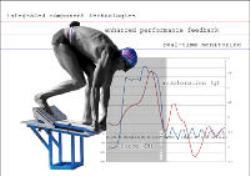By Kalwinder KaurJun 30 2012
Supported by Engineering and Physical Sciences Research Council (EPSRC), Loughborough University's Sports Technology Institute and British Swimming have jointly developed a new system that integrates advanced movement tracking and sensor technologies. Queen Mary University of London, UK Sport, and Imperial College London are also partners in this development.
 A swimmer with the wireless node connected to their back (select image for larger version)
A swimmer with the wireless node connected to their back (select image for larger version)
The system produces an overall data on the swimmer's body position, speed and acceleration. By using this system, coaches can produce instant and more detailed feedback and suggestion. The data can be accessed with the help of a laptop. Interpretation of the information will be extended by experts, followed by carrying out the necessary modification of the swimmer's technique while training.
The Loughborough team has upgraded the already-existing sensing and motion tracking technologies for deployment within the system, and also combined the features within a single, integrated package. The system has been developed based on the innovative patentable technology, through which can achieve wireless transmission of data via water.
Previously, coaches used eye impression and video footage for providing feedback while training. The swimmer's back is fitted with this new system, a compact, streamlined box of 80x50 mm and 12 mm thick having gyroscopes, tiny accelerometers, and other sensing technologies. Force transducers are in-built within the starting blocks and pressure sensors fitted to touch pads at the finishing point of swimming lanes. When fitted to the swimmer's hips or other body areas, Waterproof LED markers enable monitoring of body movements.
While the swimmer is moving, the data will be transmitted to the laptop, and the information will be interpreted and displayed by the modified software. Alternatively, video footage will be generated by the cameras mounted atop and beneath the waterline. The data contains the time period a swimmer spends in the air while diving, the force of the swimmer's push-off from the blocks, their stroke rate, the angle of their body while entering the water, and the length of time contacting the pool wall.
The current system’s medical applications include assessment of the rehabilitation performance of stroke patients, while industrial applications are wireless tracking of high-value components or assets in demanding factory conditions.
Disclaimer: The views expressed here are those of the author expressed in their private capacity and do not necessarily represent the views of AZoM.com Limited T/A AZoNetwork the owner and operator of this website. This disclaimer forms part of the Terms and conditions of use of this website.